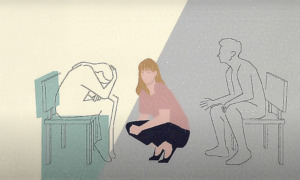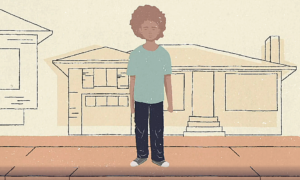
MonkeyBusinessImages/Shutterstock
.
When Carlos first came to live with us he was about 16. A friend of my son’s, he had a long history of family and housing instability and had been recently kicked out by his mom. As his informal host, I thought I did everything “right.” We already had a strong relationship; I met with his mom, laid out house rules and talked about his plans for the future.
What I didn’t take into account was the influence of all the systemic factors he battled on a daily basis. As a black woman, I understood the impact of racism, poverty and the other oppressions Carlos had to navigate. Understanding alone doesn’t prevent us from experiencing the harm.
As a young black man, there were concrete ways these frames played out in Carlos’ everyday life. He couldn’t get a job due to his felony, and even though he had a roof over his head and food in his belly, that wasn’t enough to prevent him from making money the way he knew how. Carlos also battled mental health issues due to childhood trauma; aside from anger management classes, there were very few resources for young black men to engage in healing. Finding housing was just the beginning of the support he needed.

Stacey Ault
Carlos stayed with us on and off for a few years. I heard rumors he had been getting in trouble and didn’t want to bring any negative traffic to our house. So, without giving me a lot of details, he decided it was time to move on. A few months later he was arrested for a robbery, and after a few probation violations and some new charges, served a couple of years in prison. He would call periodically. I thought of him often.
When Carlos was preparing for his release from prison, he struggled with finding a place to go. He paroled to a relative’s house and almost immediately showed up on our doorstep. He said, “There was too much going on over there Mama Stacey.” We hadn’t communicated as much as we would have liked while he was gone, but there was no way we were going to have him on the streets.
I engaged with Carlos the way I engage with most youth — as a black mama. I cared deeply, and did what I could to provide him the best type of support. In addition to being Mama Stacey, I am also a scholar, a researcher, a social worker and an advocate. All these identities didn’t enable me to wave a magic wand and transform life for Carlos. They also didn’t totally equip me to navigate the complexities of youth homelessness as it intersects with the criminal justice system. Even if I knew “what” to do, it didn’t mean I had the internal and external resources to do it. I also recognize I am more privileged than most.
Hosts need resources, help
Youth experiencing reentry are often negotiating their own housing, which can mean going to stay with someone in their network of natural supports. These arrangements fall under the umbrella term of “couch hopping,” which covers everything from crashing for a few nights here or there with peers to staying longer-term in a home where a responsible adult is present.
As estimated by Chapin Hall based on representative samples of youth and households across the U.S., approximately 1.3% of 13- to 17-year-olds have couch hopped within the prior 12 months without experiencing “explicit” homelessness, and 4.5% of 18- to 25-year-olds self-report this experience. These estimates are likely higher if we consider that many youth experiencing “explicit” homelessness are also couch hopping at some point in their experience of homelessness.
When Carlos came to stay with us after being released from prison I grappled with questions such as: How do I best support Carlos’ reentry, beyond making sure he has a roof over his head? How do we keep the other members of the household safe, when the parole officer has almost free rein to raid, or “search,” the home at any time? How do we negotiate expectations and boundaries, when young people have been subjected to the abusive rules of incarceration? How can we help Carlos get access to culturally relevant supports that would address mental health needs? These were often needs that were exacerbated by his time in prison.
Often, hosts like me want to help, but probation/parole rules can complicate assisting a youth in taking positive steps forward, especially for hosts and youth who are of color or indigenous. In addition, service providers often seem to take a “hands off” approach once a young person has landed a place to stay. Sometimes they don’t engage with the host at all, offering no further support to stabilize what could be an ongoing source not just of shelter, but also connection and belonging.
That a young person in a precarious housing situation would simply show up on the doorstep of someone they think might be able to help them is actually logical — and enterprising — behavior. Though the potential host may be caught off guard upon opening their front door, the criminal justice and social services systems should be able to prepare for what is, essentially, predictable behavior.
When a young person tells a case worker they are going to stay with their “older cousin” or “their mom’s best friend,” the service provider can start by asking questions to ensure the arrangement is supportive, stable and safe for everyone. Support for setting up household agreements and navigating conflict can help insure the long-term stability of the hosting relationship.
Listen to the hosts
Also important is helping hosts provide developmentally appropriate supports that are attuned to youth’s prior (often traumatic) experiences, while also creating a sense of stability for everyone living in the household. This may also include knowing how and where to reach out for professional support. Sometimes just being seen as integral to the young person’s journey, and having someone to talk to about everything that’s going on, is impactful enough.
I have hosted many young people over the years who were grappling with housing instability. I have also researched this phenomenon in my academic role. I’ve noted that what little academic attention has been given to couch hopping youth has focused on the perspective of the youth. This is paramount. However, the perspective of hosts can also provide insight into complex dynamics that youth may not always share or even be aware of. Stabilizing the often very meaningful arrangements between youth and their hosts means we must make space to explore the narratives of everyone involved.
To that end, I’ve recently been collaborating with my colleagues, Susanna Curry, Mallory VanMeeter and Brenda Tully, to analyze interviews conducted by CloseKnit of young people 16 to 24 years old who were dealing with housing instability by staying with adults who were at least 10 years older. Plus, we’re also examining CloseKnit’s interviews with adult hosts. While couch hopping is often viewed pejoratively — as youth who are unstably housed and at risk for exploitation (which is certainly sometimes the case) — I recognized aspects of Mama Stacey in the host transcripts. Exploring their stories makes me feel heard.
We’ve begun sharing what we’re learning from these stories in academic contexts. Our challenge now is turning these stories into tangible and concrete action so youth and hosts receive the guidance and support they need to sustain these meaningful connections.
When Carlos first came back from prison he was motivated and focused. He began job hunting and enrolled in anger management class, which is often the sole extent of mental health services for reentry youth. He was much older now, not really a youth anymore. Resources were still limited. He found it harder to follow household rules and navigate around other people in the home. Carlos moved out with family members after about six months. I think of him often.
Stacey Ault, Ed.D., is an assistant professor in the Division of Social Work at Sacramento State University. Her research explores critical post traumatic growth among black women and youth and other oppressed groups.































